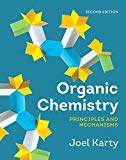
(a)
Interpretation:
The product with greater abundance in the given
Concept introduction:
The
(b)
Interpretation:
The product with greater abundance in the given
Concept introduction:
The
Want to see the full answer?
Check out a sample textbook solution
Chapter 8 Solutions
Organic Chemistry: Principles and Mechanisms (Second Edition)
- Draw the products (including the stereochemistry) formed in the following reaction.arrow_forwardGive the organic product formed in each of the following reactions, draw a 3-D representation for the product molecule showing the correct configurationarrow_forwardAn acid–base reaction of (R)-sec-butylamine with a racemic mixture of 2phenylpropanoic acid forms two products having different melting points and somewhat different solubilities. Draw the structure of these two products. Assign R and S to any stereogenic centers in the products. How are the two products related? Choose from enantiomers, diastereomers, constitutional isomers, or not isomers of each other.arrow_forward
- Isopulegol is formed as a single stereoisomer. Account for the fact that only a single stereoisomer is formedarrow_forwardThe trityl cation intermediate is a highly stable species due to the resonance stabilization provided by the phenyl rings. Please draw these resonance structures.arrow_forwardNon-conjugated β,γ-unsaturated ketones, such as 3-cyclohexenone, as in acid-catalysed equilibrium with their α,β-unsaturated isomers. The mechanism has several intermediates. Draw the structure of the second reaction intermediate in the conversion of 3-cyclohexenone to 2-cyclohexenone. This intermediate is a neutral compound.arrow_forward
- The following molecule undergoes an intramolecular reaction in the presence of pyrrolidinium acetate, the protonated form of pyrrolidine. Draw the product of this reaction, assuming that a dehydration reaction takes place.arrow_forwardWhen (R)-6-bromo-2,6-dimethylnonane is dissolved in CH3OH, nucleophilic substitution yields an optically inactive solution. When the isomeric halide (R)-2-bromo-2,5-dimethylnonane is dissolved in CH3OH under the same conditions, nucleophilic substitution forms an optically active solution. Draw the products formed in each reaction, and explain why the difference in optical activity is observed.arrow_forwardTamoxifen is a drug used to prevent and treat breast cancer. What are all the possible metabolic reactions for this drug? Aromatic hydroxylation Epoxidation ON-dealkylation Benzylic hydroxylation O Epoxidation followed by epoxide hydrolysisarrow_forward
- Which reactant in each of the following pairs undergoes an elimination reaction more rapidly? Explain your choice.arrow_forwardAlthough γ-butyrolactone is a biologically inactive compound, it isconverted in the body to 4-hydroxybutanoic acid (GHB), an addictive andintoxicating recreational drug. Draw a stepwise mechanism for thisconversion in the presence of acid.arrow_forwardThe Stork reaction is a condensation reaction between an enamine donor and an α,β-unsaturated carbonyl acceptor. The overall reaction consists of a three-step sequence of formation of an enamine from a ketone, Michael addition to an α,β-unsaturated carbonyl compound, and hydrolysis of the enamine in dilute acid to regenerate the ketone. Consider the Stork reaction between cyclohexanone and propenal Draw the structure of the product of the enamine formed between cyclohexanone and dimethylamine. - Michael addition to an α,β-unsaturated carbonyl compound, and - hydrolysis of the enamine in dilute acid to regenerate the ketone.arrow_forward
 Organic ChemistryChemistryISBN:9781305580350Author:William H. Brown, Brent L. Iverson, Eric Anslyn, Christopher S. FootePublisher:Cengage Learning
Organic ChemistryChemistryISBN:9781305580350Author:William H. Brown, Brent L. Iverson, Eric Anslyn, Christopher S. FootePublisher:Cengage Learning
 Chemistry for Engineering StudentsChemistryISBN:9781285199023Author:Lawrence S. Brown, Tom HolmePublisher:Cengage Learning
Chemistry for Engineering StudentsChemistryISBN:9781285199023Author:Lawrence S. Brown, Tom HolmePublisher:Cengage Learning


